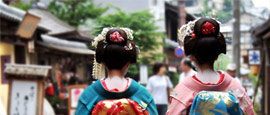This magnificent shrine is devoted to Inari, the Shinto god of rice and business, and is guarded by statues of foxes considered to be Inari's messengers at the base of Inari Mountain. A magical 4km trail lined by thousands of red-painted torii (shrine) gates winds along forested hills behind the central shrine while various smaller shrines can be found hidden up pathways away from the crowds.
Things to see in Kyoto
Tourist offices
Address: 2/F, JR Kyoto Station Building, Shimogyo-ku, Kyoto, 600 8216, Japan
Tel: +81 75 343 0548.
Opening Hours:
Daily 0830-1900.
www.kyoto.travelThe Kansai Tourist Information Centre (known as Kyo-Navi) is jointly operated by the Kyoto Prefecture and Kyoto City. It’s located on the second floor of the Kyoto Station Building where multilingual staff are stationed to assist visitors with sightseeing and transport information, advice on accommodation, restaurants and hands-on cultural activities as well as the purchase of tickets for various tourist attractions. The office also provides free maps, city guides and shopping brochures.
The Kansai Thru Pass (www.surutto.com) is a two- or three-day transport pass which allows you to ride on buses, trains and subways across the Kansai region which includes Kyoto, Osaka and Nara. The ticket also offers various discounts to key attractions.
The one-day Keihan Kyoto Sightseeing Pass (www.keihan.co.jp) can be used for unlimited train travel of Keihan lines within a designated area that covers many of the city’s temple stops and tourist districts.
History comes alive in Gion, Kyoto’s famous geisha district, defined by its narrow streets overhung with traditional wooden buildings. Along with an array of teahouses and Japanese restaurants, the area boasts plenty of performing arts venues such as Gion Corner, a theatre staging daily Kyo-mai dance performances, tea ceremonies, puppet plays and flower arranging.
Located in northwest Kyoto, the iconic Zen Buddhist temple of Kinkakuji is known as the Golden Pavilion due to its gold-foil-covered exterior. The 14th-century original was burnt down in 1950 by a novice monk to be replaced five years later by a beautiful reconstruction set on a shimmering pond amid stunning gardens that draws in daily hordes of wide-eyed, camera-wielding visitors.
One of Japan's most beloved temples, majestic Kiyomizu-dera, meaning “pure water temple”, perches precariously on a steep hillside in eastern Kyoto and is known for its wooden ledge jutting out from a beautifully preserved main hall over sweeping city vistas. The temple was founded in 798 above the sacred waterfall of Otowa-no-taki, believed to bestow health and longevity.
Southwest of the Imperial Palace lies Nijo Castle, completed in 1626 under the reign of Tokugawa Ieyasu, founder of the Edo Bakufu military government. Its distinct layout consists of two concentric rings of impenetrable fortifications, while the ornate interiors boast beautiful decorations. Popular all year round, the castle’s gardens are also a key site during cherry blossom season.
The mysterious Zen garden at Ryoanji Temple in northwest Kyoto consists of raked white gravel scattered with 15 abstractly positioned rocks that leave many visitors perplexed as to their esoteric significance. A sense of calm and contemplation pervades its wooded grounds and pond whilst the viewing platform is a popular spot during the cherry blossom season. To accompany the spiritual experience, there are walking trails and a restaurant that serves various dishes based on Yodufu (boiled tofu), a local delicacy.
Built in the 1480s, Ginkakuji Temple – or the Silver Pavilion – is a masterpiece of minimalist elegance complete with manicured gardens and a reflective pond that creates a vision of natural harmony. From the temple, it’s a picturesque walk along the Philosopher’s Path that hugs a cherry-tree-lined canal passing a number of shrines and temples to reach the neighbouring Nanzen-ji Temple.
See how royalty lived at Kyoto Imperial Palace (Kyoto Gosho) which, until 1868, was the residence of the emperor of Japan. Set in the expansive Imperial Park, the complex preserves an ambience of regality with different architectural styles representing various eras. Visitors must pre-apply for access and tours of the grounds and should take identification.
Located just behind Yasaka Shrine, Maruyama-Koen is a resplendent green oasis complete with gurgling streams, well-tended gardens and leafy pathways that meander between restaurants, souvenir shops and cafes. Come April its serenity is broken by excitable hordes of tourists and locals who gather for spring-welcoming hanami - the viewing of the city’s majestic cherry trees in bloom.
Nowhere better displays the diversity of Japanese cuisine than Kyoto’s iconic four-century-old market the stretches along a narrow-covered walkway parallel to the Shijo-dori shopping precinct. Its bustling stalls are crammed with a bewildering array of fresh seafood and pickled vegetables, tofu doughnuts and sticky mocha (rice cakes), that liberate the senses and offer a tantalising insight into local life.
Do you have any Feedback about this page?
© 2025 Columbus Travel Media Ltd. All rights reserved. No part of this site may be reproduced without our written permission, click here for information on Columbus Content Solutions.








 You know where
You know where